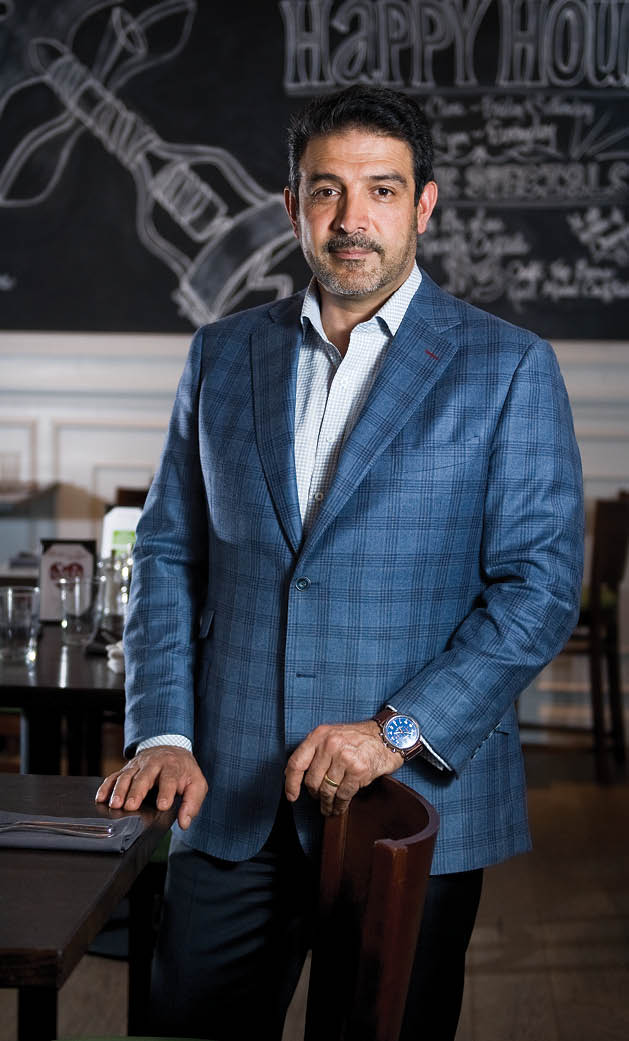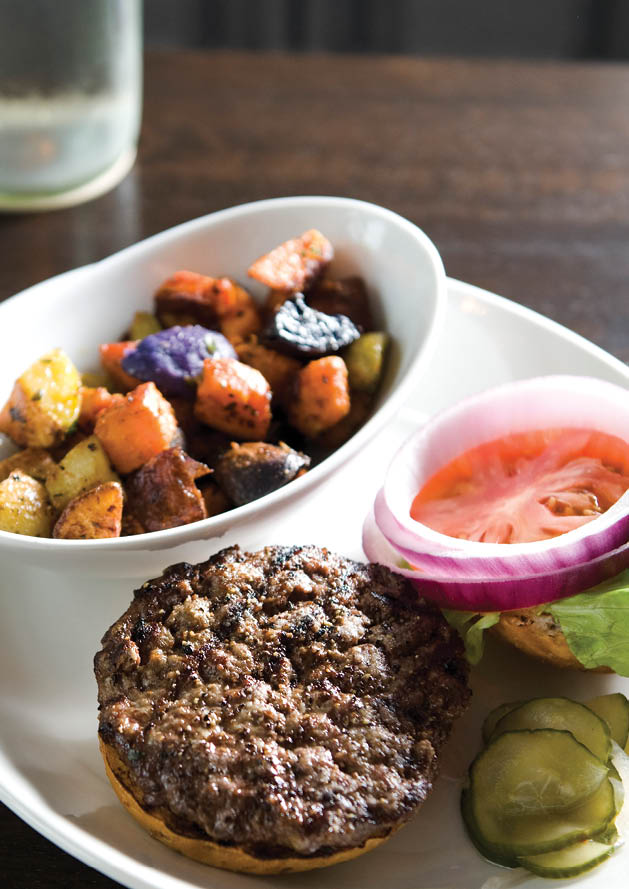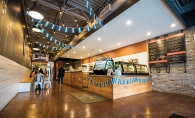Anoush and Elli Ansari of Tonka Bay have been eating organic at home for 15 years. It’s a personal choice that’s turned into a passion—and a mission—for Anoush and his business partner, Tim Cary. They launched District Fresh Kitchen + Bar in Wayzata last August, serving up organic, fresh, local foods in an upscale yet relaxed atmosphere.
Their team creates imaginative, fresh takes on familiar favorites, and finds opportunities to educate guests on the importance of their shopping and eating choices.
“Unfortunately, the most readily available food is highly processed so that it travels well and has a long shelf life,” says general manager Tim Hughes. He remembers perusing the St. Paul Farmers Market with his parents as a kid, and has made healthy, local eating a way of life both personally and professionally. He cites a Worldwatch Institute statistic that says food in America travels an average of 1,500 miles from producer to plate. Because it travels so far in less-than-optimal conditions, more food goes to waste. “Eating local food tastes better, it’s better for you, it’s good for the environment, and it supports the local economy,” Hughes explains.
But eating that way isn’t always easy. Sourcing local—and mostly organic—foods in Minnesota’s climate means the culinary team has to get creative and change up the menu on a regular basis. There are some staples on the menu: trademark dishes like Chilean sea bass, ahi tuna or salmon poke that contain main ingredients that can’t be sourced locally. But many main dishes and sides swap out as availability shifts with the seasons. Visit in late summer or early fall, and you’ll see a plethora of locally grown bounty on the menu. Regardless of the origin of the food, the District team doesn’t compromise on quality and flavor. To round out the menu, they work with local producers like Turtle Bread Company, Bass Lake Cheese Factory, Revier Cattle Company and Caves of Faribault to ensure as much of the menu as possible is coming from small, local companies.
“We use the best products—superfoods like kale and yam, whole grains like farro and quinoa. Everything tastes good, but it’s also good for you,” says Anoush Ansari. The amazing flavors help redefine diners’ understanding of what it means to eat well. “It’s healthy food, so people expect a lack of flavor, portion or choices…but that doesn’t have to be the case,” Ansari adds.

(District Fresh owner Anoush Ansari)
District’s drink menu also features a host of fun flavors. There are cold-pressed juices in a line-up of mixed cocktails, and nonalcoholic ginger beer brewed right at the restaurant. “The philosophy we share company-wide is, if you start with good, high-quality ingredients, you don’t have to do a lot to it,” says Ansari. The restaurant supports local producers and offers tasty options that encourage a healthy lifestyle. They also avoid steroids, chemicals and pesticides in their foods. “You are what you eat!” says Ansari.
The clean, fresh menu is mirrored by the airy, pastoral space in which it’s served. The space was new construction when the restaurant moved in, so the team had a completely blank slate on which to build. “It’s interesting to take a new shell of a building and make it into something—a lot of things have to come together to make that happen,” says Elli Ansari. The team needed to strike a perfect balance between familiar and fancy, open and intimate. The space features 12-foot ceilings and organic, earthy finishes—solid beechwood tables with clean gray tile. There’s a patio, but even indoors, windows open up to let fresh air in when the weather allows. “It’s a new-school neighborhood spot. We’re reinventing that place people go to hang,” Elli adds.
“Being in an upper-scale suburb, we wanted to capture the feeling of a nice night out—but also warm and comfortable enough. Whether it’s for a special occasion, just a glass of wine, a burger or pizza,” says Anoush.
To remain laid-back yet flavor-forward, District serves weekend brunch until 4 p.m. They cater to families, with a dedicated kids’ menu designed for young palates. For the after-work and adult crowds, daily happy hours from 3 to 6 p.m. and 9 p.m. to close feature $5 wines and great deals on small plates. There are also monthly special events like beer and wine tastings.
“People like the space,” says Elli. “It’s comfortable. Beachy. During a long winter, there’s a lot of sunlight that comes in. People tell us, ‘I want to live here.’"

(The dining space at District Fresh Kitchen + Bar is laid-back and inviting, with tables for groups and a bar that serves up from-scratch cocktails and daily happy hour specials.)
A Taste of District Fresh Kitchen + Bar
We rounded up a few dishes exemplifying District’s commitment to serving fun, local ingredients that celebrate the seasonal bounty of the Midwest.
Baby kale & chicken salad. The natural caves in Faribault, Minn. have been turning out local products for a long time. They were used to store beer beginning in the mid-1800s, and later became home to artisan cheeses. In the 1930s, the first American-made blue cheese was developed there, just in time for the shipping restraints of World War II to shut down the supply coming from Europe. Caves of Faribault started doing business in 2001, with a nearby outlet store and restaurant that feature the trademark blue. A number of Twin Cities co-ops and grocery stores carry the products, and there’s an online store, too. Restaurants like District showcase the special local cheese in dishes like this seasonal salad.
Mediterranean pizza. Try this riff on a traditional pie, which stars beautiful Bass Lake chevre from neighboring Somerset, Wisconsin. When Bass Lake Cheese Factory went into business in 1918, there were over 2,800 cheese factories in the state. Now, with fewer than 200 Wisconsin cheese producers still in business—and many turning to mass production—Bass Lake refuses to change its ways. (And we’re grateful!) “Sure, you can put a slice of American cheese on a burger…but it’s not going to taste the same as adding quality, handmade cheese,” says Bass Lake Cheese Factory general manager Sarah Martinsen. “It’s truly farm-to-table. Nothing is mass-produced, and we’re never going to skimp on quality.” Here’s a plus: Besides finding their chevre on this District favorite and at two markets in the area, you could make a day trip to the store and restaurant just over the border. It’s only about an hour’s drive from the western suburbs.
Grass-fed burger. Breads were custom developed by Turtle Bread in Minneapolis just for District, and they’re the result of many rounds of (very yummy) tests and revisions. The signature breads are all made by hand in small batches on 48th Street and Chicago Avenue, and the Turtle brand has also launched two other restaurant and bread store locations in the Linden Hills and Longfellow neighborhoods. What’s up with the name, you ask? “You can’t make great bread fast—you have to make it slowly, and you’ll get a much better flavor,” says owner Harvey McLain. This burger features a delicious Turtle bun. And the grass-fed burger patty comes from another Minnesota family-run company. In 1867, Revier Cattle Company began as a family homestead in Renville County. The company—several generations of Reviers later—is about creating a delicious product, and doing it ethically and sustainably. We’ll take a bite of that.

(Burgers on the District menu are made from grass-fed beef patties with fresh, locally sourced fixings.)









